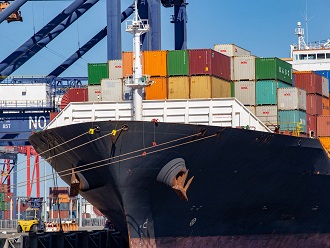By Karina Boudjema
Vice President of Global Carrier Strategy and Digitisation
The maritime industry is inherently international, and also inextricably linked to the landside. The supply chain crosses borders and wharves and extends into the hinterland far from the ocean. Because of its international and intermodal scope, the regulations and standards that govern the maritime industry must have an equally broad scope.
However, the international supply chain is not static. Changes in governmental and business processes, coupled with advances in technology, have both necessitated and made possible greater connectivity up and down the supply chain.
 It is technically possible for each link in the supply chain to communicate instantaneously with every other link. Such interconnectivity between businesses, governments and other organisations up and down the supply chain is yet to be realised. One stumbling block is a lack of agreed upon standards. There are efforts to overcome this and build a regulatory framework for the development of standards.
It is technically possible for each link in the supply chain to communicate instantaneously with every other link. Such interconnectivity between businesses, governments and other organisations up and down the supply chain is yet to be realised. One stumbling block is a lack of agreed upon standards. There are efforts to overcome this and build a regulatory framework for the development of standards.
Existing structures
While the IMO develops and maintains a comprehensive regulatory framework for the maritime industry, data exchange harmonisation is beyond its remit. Instead, the organisation the UN Centre for Trade Facilitation and Electronic Business (UN/CEFACT) works to develop and maintain such standards. UN/CEFACT, along with ancillary organisations, have established working groups to address issues of standards for data exchange in the industry.
But technology companies have been ahead of the curve, developing their own standards and interfaces. Systems such as electronic data interchange (EDI), application programming interface (API), are in widespread use across the logistics industry. The technology companies that have developed these systems have come at the issue from an agile mindset, finding ways to translate data and information from one format to another.
The future towards interoperability
Interoperability, or the ability for computers to exchange and use data, will continue to be important as a vehicle to reinforce standards. Increasing interoperability would mean the broader supply-chain network would gain value from adopting universal standards. A technology provider offering a solution that doesn’t take on the full scope of the issue would have little chance of succeeding. Many have tried. While solutions tend to be promising at first, narrow scope limits growth. But, larger technology providers have been building supply-chain ecosystems for many years to create value-added services.
Container-shipping companies are beginning to recognise the imperative to digitise supply chains. These companies are looking to apply developing technologies such as the internet of things (IoT), distributed ledger technology (or blockchain), machine learning, and end-to-end supply-chain data management systems.
However, due to the complexity of the industry and the lack of adoption of universal standards, the task of digitalisation is complex. For instance, ports are frequently referred to with different codes by different stakeholders in the supply chain. This despite the best efforts of UN/CEFACT to harmonise these port codes.
Lack of adoption of standards such as port codes stems from the slow adoption of technology solutions within the supply chain. Different systems are unable to communicate, and this, in turn, prevents true interoperability throughout the supply chain.
A new hope
A step towards true interoperability was the April 2019 launch of the Digital Container Shipping Association (DCSA). The neutral, non-profit organisation aims to drive interoperability and standardisation in the container-shipping industry. Most of the largest ocean carriers have agreed to support the DCSA. Its members represent more than 70% of the global TEU capacity.
The DCSA hopes to address the common challenges experienced by all of the container shipping companies in transmitting, receiving, and exchanging data. A broad aim of the organisation is to function in the shipping sector like the International Air Transport Association (IATA, founded in 1945) functions in the aviation sector.
It is still early days for the organisation, and it has yet to make any substantive announcements regarding its activities. It has yet to announce which technology provider, or providers, to partner with.
The DCSA seems to be looking at enabling differentiated offerings, cost-effective and value-added services for the container shipping companies. The potential benefits across the wider transportation sector could be tremendous, with greater connectivity and decreased cyber risks.
However, the DCSA has a steep climb ahead of it. The ocean carriers are notoriously competitive. It remains to be seen whether they can put aside their differences long enough to work as a united front and thrash out a set of usable industry standards.
As the adage goes, “standards are like toothbrushes, everyone agrees you should have one but no one wants to use yours”.
Other supply-chain stakeholders, such as shippers, have yet to be heard from regarding these standards. The benefits that an organisation such as the DCSA could bring would certainly be a boon for all actors in the supply chain.
Warming to tech
Outside of their interest in the DCSA, many ocean carriers have shown an increased willingness to invest in adjacent technology. Many carriers have joined forces with tech companies and venture-capital firms to create platforms based on these technologies.
The sun is setting on the current, fragmented mode of supply-chain connectivity. It is being replaced by dedicated platforms that can provide straight-through digital processing for all parts of the supply chain.
If managed properly, the DCSA can lead the way towards a new, more connected and transparent supply chain by establishing workable industry standards. While this organisation is the best hope at present to drive standardisation in the industry, its next move will be critical.